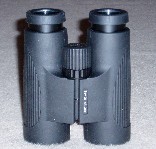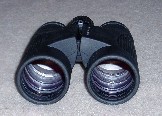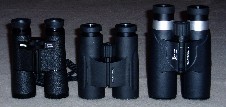

There is a rule of thumb saying: A roof prism binocular, compared to a Porro prism of same quality, is twice as expensive and 30% less heavy. In fact, there are a couple of technical obstacles entangled with the roof prism design: The manufacturing tolerance is quite low, it doesn't employ total reflection of the prism but requires two mirrored surfaces, and the light beam is split and later on rejoined, and here a phase shift has to be compensated for with an additional phase coating layer. These circumstances imply that, in general, cheap roof prism binoculars are of low quality, compared to Porro prisms, which, with some luck, can be found in decent quality for 100 Euro. Another implication is that technological advance in roof prism devices is still going on with some momentum, whereas Porro prism binoculars of very high quality have been available since decades.
The 10x40, or 10x42, is a classical size for roof prism glasses, because here the advantage of this design is of particular impact: With 10x, we are at the limit of hand-held binoculars, and the low weight of the roof prism makes it easier to handle. In this review, a new product of Docter, the 10x42 B/CF, is compared to a classical high end binocular of Zeiss, the Dialyt 10x40 B, and an interesting new import from China, the TS 10x42.
Fig.1: The Docter 10x42 B/CF.
Docter has got experience with roof prism technology, having the 7x40 B/GA (the former NVA EDF 7x40 military glass) and a fairly new 10x42 B/GA of same design in their product line. With their military heritage and individual focusing oculars, these glasses may be applied under especially tough conditions. The new B/CF 10x42 is apparently based on the classical Notarem 10x40 of Zeiss Jena, and it points toward the high end clients, with a wide field of view, spectacle-friendly oculars (B), twist-up eyecups and a central focuser (CF). A four lens objective (quadruplet) is employed to create a proper image quality. The binocular is nitrogen filled, fully sealed with internal focusing technique, and specified to be water proof up to 3m. It is delivered without carrying case and, which is annoying, without objective lens covers. The price tag is in the 700 Euro range.
Fig. 2: The Zeiss Dialyt 10x40 B of the 1970s
The Zeiss/Hensoldt Dialyt is a classical binocular, introduced as early as 1905, shortly after invention of the roof prism design by Hensoldt in 1897. The modern form of the Dialyt (with Schmidt/Pechan prism construction) was introduced in 1964 and continually improved since then, and in 1981 the Zeiss 7x42 Dialyt came with the more advanced Abbe-Koenig prism system. At any time, the Dialyt defined a benchmark for high quality roof prism binoculars. In 1979, the multilayer T* coating was introduced. The Dialyt to be tested (serial number: 1508511) is still with single-layer coating and perhaps made in the 1970s. The phase-correction coating was invented in 1988 only, so the Dialyt is still without. It has a central focuser, but no internal focusing - instead, the objectives are moving in and out. The binocular is sealed against dust and rain, but not fully water proof. In good condition, it is still selling for up to 400 Euro on the surplus market.
Fig. 3: The 10x42 of Teleskop Service
China is not only shooting Taikonauts into space, but also quickly catching up with optical technology. A recent import by Teleskop Service features a roof prism binocular with three lens objectives (triplet), internal focusing and nitrogen filling. With 130 Euro, the TS 10x42 is cheap for a quality roof prism binocular. This heavy device comes with a metal body and a rubber armor and appears to be of solid mechanical construction. The twist-up eyecups allow for a quick adjustment, and the eye-relief of 18 mm should provide comfortable observation conditions with spectacles on. Unfortunately, it doesn't show a serial number, making it almost impossible to keep track with constructional improvements over the time.
 Fig. 4: The Zeiss Dialyt, Docter B/CF and the TS
Fig. 4: The Zeiss Dialyt, Docter B/CF and the TS
The following table summarizes some of the specifications of the contenders.
| Real angle | Apparent angle | Eye relief | Exit pupil | Weight | |
| of view (deg) | of view (deg) | (mm) | diam. (mm) | (kg) | |
| Docter 10x42 B/CF | 6.5 | 65 | 14 | 4.2 | 0.8 |
| TS 10x42 | 6.1 | 61 | 18.2 | 4.2 | 1.0 |
| Dialyt 10x40 B | 6.3 | 63 | 15 | 4 | 0.7 |
Image sharpness: The image quality is on a high level, as was to be expected at least for the Zeiss and the Docter. Both of them show variations in their correction philosophies: Observing the stars, the Zeiss is sharp from the center to about 70% (radial) toward the edge, and then slowly getting soft. At the edge, the aberrations remain on a moderate level. The Docter has a field which is sharp until 80%, and then the image is rapidly degrading. We thus have the situation that from center to 70% both are on par, from 70% to, say, 85% the Docter is sharper, and from 85% to the edge the Zeiss is sharper. A positive surprise was the TS: It seems to have taken over the better parts of both approaches, i.e. it is sharp up to 80%, like the Docter, and then only gradually decreasing, like the Zeiss. This looks like magic, but it is actually understandable: No optical system is free of aberrations. Often, a particular lens element is employed to correct for one aberration, e.g. field curvature, and by doing that it is only producing another aberration, e.g. astigmatism, which then is partially taken care of by the next lens element. With lower F-ratio ( = focal length divided by objective lens diameter) and wider field, the amount of aberrations increases dramatically. More lens elements are then needed to correct for them. As seen in Fig. 4, the TS has longer tubes than the compact Docter, so obviously its F-ratio is larger, but its angle of view is smaller. Therefore, a triplet lens is sufficient for the TS to produce a high quality image, whereas a quadruplet is required in the Docter which is, with a wider field, still struggling against the edge un-sharpness.
Image color: The Docter and the TS show a neutral color rendition. The Dialyt, however, has a slight brown-yellowish tint. The image also appears a bit pale, i.e. the colors are a little less crisp compared to the Docter or TS. During daylight, this has no significant impact on the image quality. At low light, however, the image contrast of the Dialyt is suffering (see low light section below).
Rectilinear distortion: All three of them show a slight pincushion distortion, which is implemented in order to compensate for the globe effect of the panning binocular.
Stray light: Here, the Dialyt is very strong. In a critical situation, at twilight, when the sky is scattering a diffuse light into the objective tubes and a dark forest is observed, the Docter and the TS can develop a diffuse illumination close to the lower edge of the image, which is absent in the Zeiss. In the majority of applications, those effects remain invisible in any of the three binoculars, however.
Ghost images: If, at night, a bright object (street lantern, moon) is positioned into the field, reflections on the air-to-glass surfaces take place, which can lead to multiple 'ghost' images of the light source. A good suppression of ghosting is an indicator for a high quality anti-reflection coating. Here, the Docter clearly performs best. Even bright spot lights can hardly provoke any ghost images. The Dialyt comes next; it develops a few diffuse spots of low intensity when the light is close to the center of the field. The TS shows more response, with one dim de-localized spot and a few localized reflections of low-to-moderate intensity. Although this effect is not a dramatic one, and I have seen much worse examples, it after all marks the only significant weakness of this otherwise very strong binocular. This implies that the surface coating in China has not yet reached the state of the art standards.
Low light performance: With 4mm and 4.2mm exit pupils, these binoculars are not constructed for low light conditions. Also, one may not expect any dramatic performance differences between these three glasses. This turned out to be wrong. When comparing the Docter with the Dialyt, I first stopped the observation to check the Dialyt for fogging, because the image brightness and its contrast appeared so much lower. But there was no fogging, and I had to imply that in fact the low light performance of the Zeiss was not at all competitive with the Docter, and neither with the TS. Comparing the TS with the Docter, they were close. Their image brightness seemed to be about the same, but the Docter had the edge in contrast, possibly a consequence of the high quality coating.
| Angle of | Image | Stray | Ghost | Low | Image | Mechanical | Final | |
| field | sharpness | light | image | light | color | construction | score | |
| Docter 10x42 B/CF | 3 | 1.5 | 1.5 | 3 | 3 | 2.5 | 2.5 | 17 |
| TS 10x42 | 1 | 3 | 1.5 | 1 | 2 | 2.5 | 2.5 | 13.5 |
| Zeiss Dialyt 10x40 B | 2 | 1.5 | 3 | 2 | 1 | 1 | 1 | 11.5 |
The 'final score' is the sum of the individual scores and is intended to serve as an orientation only. Generally, it would be an over-simplification of the matter to just look which binocular has got the highest score, because it would obscure the individual features of the devices which differ quite a lot among each other. See the application profiles for some additional background information.
The Docter B/CF is a real high tech machine. I was unable to detect any significant weakness in this binocular. It is not only well constructed, but comes with a pretty wide angle of view and a compact body. The coating seems to be of highest quality, and the image is bright and of high contrast. Image sharpness close to the edge is poor, but this is tolerable in a wide angle glass. Despite of the 'B' feature, spectacle wearer may have some trouble to see the entire field with glasses on. I was puzzled to find it delivered without objective lens covers. I would feel much better when carrying it around and being sure that the precious lenses were protected against environmental hazards.
The rule of thumb, as cited in the introduction, is not valid for the Teleskop Service TS 10x42. Its performance-per-Dollar ratio is high for a roof prism binocular. Of course, it is also quite heavy. But the extra weight appears to be a reasonable investment, coming along with a solid and rugged metal body construction. The image sharpness is remarkable. A weak point is its tendency to create ghost images, if at night a bright object is placed into the field. Obviously, the surface coating is not as good as found in high end binoculars - which, of course, cost multiple times more money. It is mostly this feature which separates the TS from the top class, but this could change once the Chinese manufacturer is able to further improve coating technology, with impact on ghosting and also on the low light performance. What worries me is the absence of a serial number: A binocular of decent quality is going to last for decades, i.e. it will sooner or later show up on the surplus market and, who knows, even find some collectors. Without a serial number it will be difficult to trace the history of technical improvements and, of cause, to estimate its age, and this will certainly have an impact on its value as a second hand item.
The Zeiss Dialyt 10x40 B may have been a high end roof prism binocular 30 years back, but it is not competitive any more. Although still useful for observation during daylight, image contrast and brightness are clearly inferior compared to the Docter and the TS. The Schmidt-Pechan prisms require one mirror surface - perhaps, over the decades, the reflectivity of this surface has suffered (the later Zeiss Dialyt 7x42 and the Zeiss Victory models come with Abbe-Koenig prisms where such a layer is obsolete), which would explain the apparent poor light transmission of this Dialyt. The absence of rubber armor and its limited resistance to water make it less suited for tough conditions. I think there is no point in spending up to 400 Euro for a second hand Dialyt of this age, if for 130 Euro a device like the TS is already offering more. This example demonstrates how fast the technological level of roof prism design has been shifted up within 3 decades.
Teleskop-Service, distributor for the TS 10x42 (German language web page)
Last updated: 2004